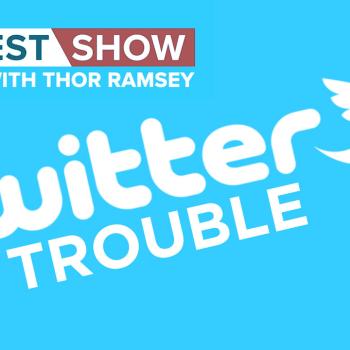
Today’s Headlines from a Christian Worldview
I’m Albert Mohler and this is The Briefing, a daily analysis of news and events from a Christian worldview.
A REVERSAL OF MEDICAL LOGIC: FAMILIES ARE NOW SUING DOCTORS FOR SAVING THE LIVES OF THEIR LOVED ONES
Here’s a headline for you:
“Saved Patients, Furious Families.”
The article appeared in the New York Times; the author, Paula Spann. The background of this is easy to understand. Doctors who once feared being sued because their patients died are now sometimes in fear that their patients will live. This is the article and the substance of what comes from the New York Times, telling us that there has been a sea change in terms of end of life care and that there are families that are actually suing doctors because they saved a life against advanced directives. These advanced directives are known by various acronyms in states. They are sometimes known as Medical Orders for Life Sustaining Treatment, that is MOLST, or as Physician Orders for Life Sustaining Treatment, that is POLST. They are advanced directives whereby an individual can indicate that he or she does not want extraordinary measures to be used if there is an incident such as a heart attack or a respiratory failure. This is often something that comes at the last stages or advanced stages of life, and yet the importance of this article is that what we are now witnessing is a reversal of medical logic, and that’s what should have our attention from a worldview perspective.
No one stated this better in this article than Thaddeus Pope. He directs the Health Law Institute at the Mitchell Hamline School of Law in St. Paul, Minnesota. As the New York Times said,
“Historically the practice has been if in doubt, err on the side of aggressive life sustaining treatment,” said Dr. Pope.
But now the logic may be shifting in the opposite direction. As Spann writes,
“Physicians and hospitals have grown accustomed to the threat of lawsuits when they fail to save the patient’s life. Now some face legal action for failing to let the patient die.”
The article opens in the case of a woman by the name of Beatrice Wiseman. Before dawn on August the 29th of 2013, we are told,
“This was not supposed to happen. The medical staff at Maryland General Hospital found her in cardiac arrest, resuscitated her and kept her alive.”
Now, they did so because that is a deeply ingrained medical instinct. They found a patient in cardiac arrest and they intervened, resuscitating the patient. However, Ms. Wiseman had had an advanced directive indicating she did not want to be resuscitated. At least some in the family, including this woman’s son, were distraught that she was resuscitated, and now the New York Times tells us that her son has brought suit against Maryland General for its treatment of his mother, alleging assault, negligence, the intentional inflection of emotional distress, and other claims.
Now that really tells us something. Here you have a son suing a hospital for resuscitating his mother. Now there is a big change in terms of medical ethics and medical practice that is coming here. That statement made by Thaddeus Pope—he’s a law professor in health law, after all—gets right to the heart of the issue. The instinct had been try to save the patient. As he said, if in doubt, err on the side of aggressive life-sustaining treatment. But nowadays that can not only get you in trouble, that can get you into court.
In the Journal of Clinical Ethics, Dr. Pope says this:
“Courts increasingly accept that unwanted life is also a harm. Families were showing up at plaintiff’s attorney’s offices in the past and getting turned away. Now plaintiff’s attorneys are taking these cases.” These are the cases brought by family members who are bringing a lawsuit against medical personnel for resuscitating a loved one.
Just last July, the Supreme Court of the state of Georgia seemed to side with this revolution in medical ethics and practice when the justices said,
“It is the will of the patient or her designated agent and not the will of the health care provider that controls.”
But here is where we need to take a step back and understand exactly what we’re looking at here. We are looking at an intentional recalibration of medical ethics. We’re looking at a reversal of the instincts we want medical personnel to have. That instinct has been deeply ingrained in the practice of medicine going all the way back to the most ancient of times. That ancient medical oath of Hippocrates begins with the words, “First do no harm.” That is the essence of the medical profession. That’s why people become doctors and nurses and other medical practitioners. It is not to harm. It is to heal and not to take life, but to preserve life.
Furthermore, in thinking of the clinical context, it’s very important to understand that instinct is often a ruling category. That’s to say that when a medical practitioner is in the context of making medical decisions, a lot of it comes by habit and intuition and the medical profession has built upon that, and furthermore the public has counted on that, has counted on the fact that that intuition is towards doing whatever reasonably can be done to save a life rather than to say there is an advanced directive here that says this person’s not to be resuscitated.
Now one of the things we’re looking at here is the fact that this is coming on the razor edge of litigation. We are looking at the fact that families are now going to court, suing medical practitioners for the extension of a loved one’s life. The pattern of this litigation is going to reveal a great deal about the future of our society. But we also need to note that embedded within these arguments is the presumption of a right to die, and specifically a right to die on our own terms.
From a Christian worldview perspective, there’s nothing categorically wrong about these advanced directives. They are intended in their most innocuous and innocent forms simply to allow a patient to say, ’If indeed I reach the point where there is some terminal disease that will take my life, I do not want my life to be artificially extended by means of resuscitation.’ But we also have to recognize that even though there is nothing inherently wrong with that pattern, that is something that is going to require decision-making on the part of medical personnel, and that decision-making will not always be consistent with an individual’s wishes.
But that raises a crucial question. Do we really want medical practitioners, doctors, nurses and others, to have to wonder at any given moment what our wishes might be, even if those wishes are in the form of the language of an advanced directive? Do we furthermore want doctors, nurses, and others worrying that if they save our lives, they will be sued? A singular lawsuit and even a singular court decision would not be determinative and likely wouldn’t even warrant that much of our attention, but the fact that this is now a leading story in the New York Times and that the issue is showing up in the medical journals for those who are training doctors, well, that tells us something big is really going on here.
And this is where we need to acknowledge that reversing a medical logic is also reversing a moral logic, and there is a great price to be paid for that reversal. I think at this point many of us would recognize that even though some of these advanced directives are certainly morally defensible, we do not want to be treated by medical personnel who are afraid that if they save our lives, we or our loved ones will sue them. By the time this society figures out just how dangerous this reversal of moral and medical intuition will be, the situation will be too late. Once you reverse this kind of intuition, it’s going to be very hard to set it right once again.
WHAT OUR RELATIONSHIP WITH ANIMALS REVEALS TO US ABOUT OURSELVES AND THE GLORY OF GOD
Next, shifting from human beings to animals, the Daily Pakistan Global edition ran a story with the headline,
“Taiwan Becomes First Asian Country to Ban Eating Dogs and Cats.”
Now that’s an interesting story. It tells us for one thing that Taiwan in passing this legislation to ban the eating of dogs and cats is actually the first Asian country to do so. That represents something of a great worldview divide between Western nations and Eastern nations in terms of the question of what we eat.
Of course that’s a rather innocuous question when it comes to vegetables and sauces but when it comes to meat, well, it turns out that’s a very different issue. Now what is the Christian worldview importance of thinking about this story? It is thinking, first of all, about the fact that we’re living in a world that increasingly confuses the distinction between human beings and the animal kingdom at large, but it also tells us something about our relationship with the creatures that God has given us, the non-human creatures.
This is where we need to recognize that even geographically, around the world there’s a distinction in the way that cats and dogs, just to take examples, are understood. In some places, they’re on the menu so to speak. In other places, they are in our laps. Something significant has changed in Taiwan, and that’s why that country becomes the very first to pass this kind of legislation. The article in the Daily Pakistan Global says that dog meat was once regularly consumed on the island, “but the animal is now more likely to be considered a member of the family.”
Now if we’re talking about moral change, that would appear to be a big one, a big one when it comes to dogs. And that raises a host of questions. For example, why is it that we seem to have such a special relationship with dogs? Evolutionary scientists have come up with many different ways to try to explain this given their own evolutionary worldview. For example, there is the argument that human beings and dogs in many societies have created a symbiosis. That is, we have created a relationship in which we reward one another for the behavior that we like. The argument from the evolutionists goes something like this: Dogs, which are naturally predators but more often even scavengers, actually thrive when they have a relationship with humans who feed them. They are no longer required to scavenge and they are much, much healthier and thus, from an evolutionary perspective, more able to reproduce if indeed they are adopted by humans who give them food. It’s a good deal for the dog, but what do human beings get in exchange? Well, here’s the argument coming from evolutionists. What we get is companionship in the form of undisguised adoration. The argument from the evolutionists is that human beings enjoy being adored. And there is no critter on earth more eager to adore us than a dog. That is the symbiosis according to the evolutionists given their own worldview. There has to be some evolutionary explanation for why we like dogs and dogs like us. The argument comes down to the fact that the dog out of the deal no longer has to scavenge and that we can simply enjoy the worship of our dogs. This furthermore gets to the entire category of pets.
Most of us have known and cherished our pets, but this is where from a Christian biblical worldview we have to understand that a part of what it means to exercise dominion over the animal kingdom is to decide which animals are to be our pets and which animals are to be kept at a distance. There’s a good reason why it is quite legitimate to have certain animals as pets and it’s considered quite bizarre if not downright wrong to try to have others as pets. One of the key distinctions that’s been recognized throughout most of human history is that humans tend to welcome into our lives animals that are not a threat to us. That just makes good sense. There’s a reason why we have very friendly dogs in our house and not cobras.
In a recent book entitled Personalities on the Plate, Barbara J. King asked the question, is this merely arbitrary? She argues that we ought perhaps to choose our pets, or at least our relationship with animals, on the basis of their intelligence, and she makes the argument that one of the most intelligent animals is the pig. But most of us do not have pigs in the house. We’d rather have pigs on the plate.
At this point, the Christian worldview simply intervenes to remind us of that basic distinction between human beings and the animal kingdom, but also to remind us that God showed his glory in the diversity of the animals he created. And even if the animal kingdom, like human civilization, demonstrates the effects of sin right down to the nature of sadistic predation, we also have to note that the animal kingdom continues to show his glory. And Christians understand that even in the differences amongst these animals and in the differences by which we use them and relate to them, there is also a reflection of God’s glory in the diversity and the wonder of what he has made.
But this is where at a worldview level, there’s a very interesting article in USA Today. This is an article with the headline,
“It’s Raining Cats and Dogs Bills.”
Erin Kelly writing for USA Today tells us that there’s a very interesting bipartisan agreement in Congress; that’s this: There is bipartisan support for any number of laws that have to do with animal welfare. That’s interesting in and of itself. Kelly notes that in an age of political divisiveness and great partisan divides, it’s very interesting. She writes,
“Congress has found something cute and cuddly to agree on. Plagued,” she says, “by bitter division and fierce infighting, Republican and Democratic lawmakers have found rare consensus on legislation to protect dogs, cats, horses, tigers and bunnies from abuse.”
Later in the article, Wayne Pacelle, President and CEO of The Humane Society of the United States, says,
“I think we’re positioned for success. You have such a diverse group of people from conservative Freedom Caucus members to moderate Republicans to liberal Democrats who have come together on an issue they know their constituents care about.”
Now there’s a political reality: it turns out that members of Congress, liberals and conservatives, Democrats and Republicans, understand that Americans like animal welfare laws. And one of the things that is often noted in terms of America’s political life, animals have taken on an entirely new significance.
You have this USA Today article that is dealing with a number of bills coming before Congress indicating that even though members of Congress seem to be unable to agree on almost anything else, they will agree in support of cats and dogs and tigers and bunnies. The very fact that USA Today refers to rabbits as bunnies tells us something about the emotional dimension of this kind of story. There is something in us that wants us to protect the lives of animals and to respect them. That tells us something good about humanity, but is that just some kind of basic human wisdom?
This is where we have to hope from a Christian worldview that there is something of the glory of God in creation that is showing through even in terms of this kind of political equation noted by USA Today in Washington.
But there’s another story that comes indicating something of the depth of our emotional relationship with animals and how we project this even on others. The New York Times ran an article with this stunning headline asking this earth-shaking question,
“What kind of pet should Donald Trump get?”
Here at the bottom line of the article by Alex Beam, he writes that,
“President Trump, rather unique amongst America’s more recent political leaders, isn’t known for having any kind of pet.”
Now let’s just ponder this for a moment. It turns out that if you go to White Houses past—and we’re looking here all the way back at least to Fala, the little dog that was often on the lap of President Franklin Delano Roosevelt during the Great Depression and World War II—if you go from successive administrations, there is almost no presidency that was not noted for its pet.
Sometimes actually it wasn’t pet, but pets. Beam writes,
“The White House has at various times hosted snakes, a badger, a lion, a hyena, zebra, bears and even elephants. The elephants were gifted to President James Buchanan by the King of Siam of that day.”
Of course that’s present day Thailand. As Beam explains,
“The animal lover and hunter, Theodore Roosevelt, doubled as zookeeper, sheltering such exotic charges as the guinea pig, Admiral Dewey, and a small bear, who went by the name Jonathan Edwards.” As Beam also writes, “More mundane pets such as Franklin D. Roosevelt’s Scottish Terrier Fala and Senator Richard M. Nixon’s Cocker Spaniel Checkers have clawed their way into American history.”
There’s another really interesting aspect of this article by Alex Beam. He argues that one of the reasons why many presidents have had dogs is because dogs are ice breakers in relationships. Even in terms of Cold War diplomacy and times of international tension, it turns out that a dog walking into the room tends to brighten the entire context and to break down barriers. If two world leaders can’t agree on anything, and even if they’re at the brink of conflict, they can at least rub the head of an adoring dog who seems to love them both. As Beam writes,
“In therapeutic literature, animals are often called social lubricants because their presence eases potentially awkward interactions.”
For Christians all this points not only to the distinction in terms of humanity and the other creatures, but it points to the fact that there is a relatedness that is given in creation as well and a glory, a glory that might cause many people in terms of a naturalistic worldview to wonder, but leads Christians to no less wonder. So while you’re thinking about these things, and understanding the glory of God in all of creation, go give a biscuit to that little social lubricant that is looking up to you with those adoring eyes. But if it is a cat, maybe you better ask permission first.
THE SURPRISING REASON WHY THE NEW YORK TIMES DISCONTINUED THEIR “ENGAGEMENTS” SECTION IN 1994
Finally when it comes to a moral revolution, sometimes it’s little things that announce a really big change. The New York Times ran an article in its Vows column. The title,
“When Engagement Notices Went Away.”
Alessandra Stanley reporting about the pattern in the New York Times indicates that the paper once was a big factor in terms of announcing engagements but at a certain point, engagement notices simply disappeared from the newspaper. The question is why? She writes,
“When Elizabeth Morris Cromwell and Thomas Guthrie Spears III agreed to marry, their engagement was announced on December the 26th, 1993 in the New York Times. As Mrs. Spears now said, it was just the thing you did when you got engaged.”
Stanley explains the Spears, who are still married and now live in Delaware, were among the last couples to make such an announcement in the New York Times. On January the 2nd of 1994, the Times announced,
“Starting today the Weddings Pages will be devoted entirely to reports of marriages. Engagement notices will be discontinued to create space for a larger number of weddings each week.”
But as Stanley now acknowledges, space it turns out was not the only reason. So what other reason might there be? Well it turns out the reason was the increased numbers of same sex unions. Not yet same sex marriage, rather same sex unions. As Stanley writes,
“Reports of same sex civil unions were not included in the society pages of the New York Times until 2002, though pressure had been mounting since the early 1990s to include announcements of gay commitment ceremonies.”
Max Frankel, the Executive Editor of the Times from 1986 to 1994 said recently that he had resisted publishing those announcements because, in his words,
“I didn’t think society was ready.”
Now there’s the big statement that reflects a really big change. Here you have the Executive Editor of the New York Times going back to 1986 to 1994 saying that in his view, back during that time, Americans were not yet ready to deal with engagement announcements from same sex couples. Stanley then writes,
“Mr. Frankel’s position was that the newspaper would not include same sex weddings until they received full legal sanction.”
She then explains Vermont would legalize same sex civil unions in the year 2000. Then she says,
“It dawned on Frankel that the marriage engagements themselves, like same sex commitment ceremonies, were self-proclaimed and unofficial.”
In his memoir written in 1999, he wrote,
“Before anyone had the time to catch my inconsistency, I killed the engagement notices, taking credit for saving us space, paper, and endless lobbying from the betrothed.”
So again, what does all of this tell us? It tells us that when the engagements section of the New York Times disappeared, the real reason wasn’t space but rather that the paper had decided it wasn’t yet the time for Americans to deal with being confronted with same sex unions in the nation’s most influential newspaper. But of course that was then and this is now. We’re talking about a sea change that has taken place just in the course of a single generation.
It turns out that the real issue wasn’t physical space in the New York Times. It was moral space. But that space is closed in America, and the New York Times itself was a driving engine of that change. But as this article indicates, as we suspected, there was a lot more to the story.
Thanks for listening to The Briefing. For more information, go to my website AlbertMohler.com. You can follow me on Twitter by going to @albertmohler.For information on The Southern Baptist Theological Seminary go to sbts.edu. For information on Boyce College just go to boycecollege.com.
(This podcast is by R. Albert Mohler, Jr. Discovered by Christian Podcast Central and our community — copyright is owned by the publisher, not Christian Podcast Central, and audio is streamed directly from their servers.)













